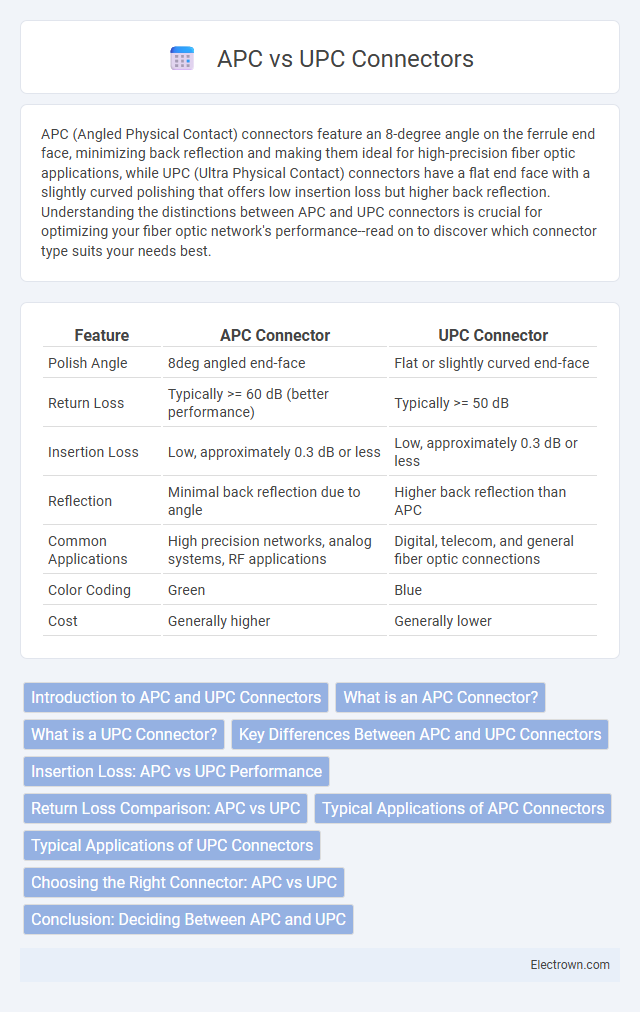APC (Angled Physical Contact) connectors feature an 8-degree angle on the ferrule end face, minimizing back reflection and making them ideal for high-precision fiber optic applications, while UPC (Ultra Physical Contact) connectors have a flat end face with a slightly curved polishing that offers low insertion loss but higher back reflection. Understanding the distinctions between APC and UPC connectors is crucial for optimizing your fiber optic network's performance--read on to discover which connector type suits your needs best.
Table of Comparison
| Feature | APC Connector | UPC Connector |
|---|---|---|
| Polish Angle | 8deg angled end-face | Flat or slightly curved end-face |
| Return Loss | Typically >= 60 dB (better performance) | Typically >= 50 dB |
| Insertion Loss | Low, approximately 0.3 dB or less | Low, approximately 0.3 dB or less |
| Reflection | Minimal back reflection due to angle | Higher back reflection than APC |
| Common Applications | High precision networks, analog systems, RF applications | Digital, telecom, and general fiber optic connections |
| Color Coding | Green | Blue |
| Cost | Generally higher | Generally lower |
Introduction to APC and UPC Connectors
APC (Angled Physical Contact) and UPC (Ultra Physical Contact) connectors are essential components in fiber optic communication, designed to minimize signal loss and reflection. APC connectors feature an 8-degree angled endface, reducing back reflections and improving performance in high-precision applications. UPC connectors have a flat or slightly curved endface, offering lower insertion loss and suitable for general-purpose connections, making your choice critical based on system requirements.
What is an APC Connector?
An APC (Angled Physical Contact) connector features an 8-degree angled end face designed to minimize back reflection and signal loss in fiber optic networks. Commonly used in high-precision applications like telecommunications and CATV systems, APC connectors offer superior return loss performance compared to UPC connectors. Their angled polish reduces reflected light by directing it into the cladding rather than back into the source.
What is a UPC Connector?
A UPC (Ultra Physical Contact) connector features a polished end face that reduces back reflection, ensuring a low insertion loss and improved signal quality in fiber optic networks. It is commonly used in high-speed telecommunications and data transmission systems where precise alignment and minimal signal degradation are critical. UPC connectors have a flat or slightly curved end face, distinguishing them from APC connectors, which have an angled end face to further reduce back reflection.
Key Differences Between APC and UPC Connectors
APC (Angled Physical Contact) connectors feature an 8-degree angled endface, minimizing back reflection to values typically below -65 dB, making them ideal for high-precision applications such as fiber optic sensing and high-speed telecommunications. UPC (Ultra Physical Contact) connectors have a flat, polished endface with return loss around -55 dB, providing lower insertion loss but higher back reflection compared to APC. The primary difference lies in their polishing style and back reflection performance, with APC connectors offering superior return loss due to their angled design, while UPC connectors are more cost-effective and widely used in general-purpose fiber optic networks.
Insertion Loss: APC vs UPC Performance
APC connectors typically exhibit lower insertion loss than UPC connectors due to their angled end-face design, which minimizes back reflections and signal degradation. UPC connectors, with their flat polished end faces, offer slightly higher insertion loss but are suitable for shorter distance applications where return loss requirements are less stringent. Your choice between APC and UPC connectors should consider the balance between insertion loss performance and application-specific needs, such as return loss sensitivity and network distance.
Return Loss Comparison: APC vs UPC
APC (Angled Physical Contact) connectors typically offer superior return loss performance, often achieving values better than -65 dB, compared to UPC (Ultra Physical Contact) connectors which generally provide return loss around -50 dB. This significant difference makes APC connectors preferable in high-precision optical networks, where minimizing back reflections is critical. The angle in APC connectors reduces reflected light by directing it into the cladding, enhancing signal quality and reducing interference in fiber optic communications.
Typical Applications of APC Connectors
APC connectors are predominantly used in high-precision optical communication systems such as fiber-to-the-home (FTTH), telecommunications, and data centers due to their low back reflection and superior return loss performance. Their angled end-face design makes them ideal for applications requiring minimal signal interference, including analog CATV and high-speed fiber optic networks. Choosing APC connectors ensures optimal signal integrity in your sensitive optical connections where performance is critical.
Typical Applications of UPC Connectors
UPC connectors are commonly used in data communications, telecommunications, and CATV systems where low insertion loss and back reflection are crucial. Their precise alignment and polished surfaces provide reliable performance in single-mode fiber applications, making them ideal for high-speed broadband networks and long-distance transmissions. UPC connectors are also favored in environments requiring frequent connections and disconnections due to their durable design and consistent optical performance.
Choosing the Right Connector: APC vs UPC
Selecting between APC (Angled Physical Contact) and UPC (Ultra Physical Contact) connectors depends on the specific application requirements for return loss and insertion loss performance. APC connectors feature an 8-degree angled end-face that minimizes back reflections, making them ideal for high-bandwidth and high-precision networks such as FTTH and DWDM systems. UPC connectors provide a flat polishing finish with lower insertion loss but higher return loss, suitable for standard single-mode applications where cost-efficiency and lower signal degradation are essential.
Conclusion: Deciding Between APC and UPC
APC connectors provide superior return loss performance, typically around -60 dB, making them ideal for high-precision applications and long-haul fiber optic networks. UPC connectors, with return loss around -50 dB, offer lower insertion loss and cost-effectiveness suitable for short-range and general-purpose use. Choosing between APC and UPC depends on the necessity for reduced back reflection or budget constraints in fiber optic system design.
APC vs UPC connectors Infographic

 electrown.com
electrown.com